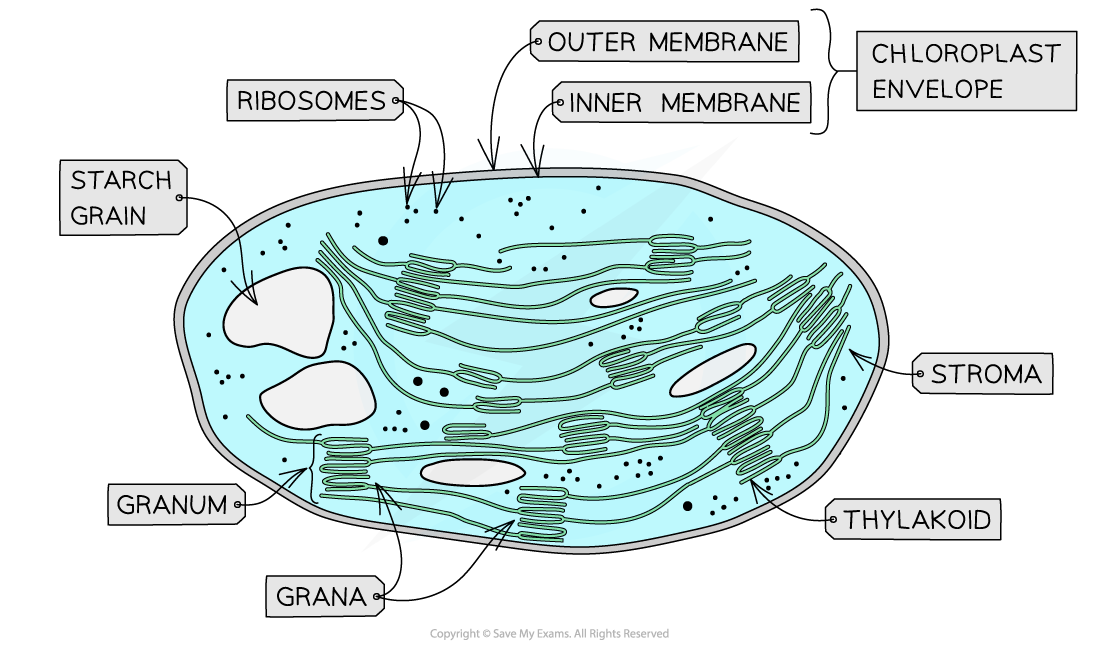Photosynthesis Overview (College Board AP® Biology): Study Guide
Photosynthesis & energy
Photosynthesis allows organisms to capture and store energy for use in biological processes
During photosynthesis light energy enables the conversion of simple, inorganic compounds into carbohydrates
Carbon dioxide (CO2), water (H2O) and light energy make carbohydrates and
oxygen (O2)
The energy captured is stored within the bonds of these new organic compounds
The carbohydrates produced can be used in other biological processes (e.g. celluar respiration) or stored (e.g. as starch)
The simple equation for photosynthesis is:


Examiner Tips and Tricks
Remember, energy is never created or destroyed; it is only ever converted from one form to another.
The evolution of photosynthesis
Photosynthesis first evolved in prokaryotic organisms, such as cyanobacteria
Prokaryotic photosynthetic pathways provided the foundation for the evolution of eukaryotic photosynthesis
Oxygenation of the atmosphere
Evidence indicates that Earth's atmosphere changed due to photosynthesis in early cyanobacteria
The first life forms emerged around 4 billion years ago; at the time, there was no oxygen in the atmosphere
About 3.5 billion years ago, cyanobacteria became the first organisms to carry out photosynthesis, beginning the release of oxygen into the atmosphere
Banded Iron Formations (BIFs): Dissolved iron II ions (Fe²⁺) in ancient oceans were oxidised to iron III ions (Fe³⁺) and precipitated as iron oxides; this requires free oxygen, which was gained from photosynthesis
Ancient stromatolites (layered microbial mats) are abundant and are often linked to cyanobacterial communities
The molecular structures of oxygenic photosynthesis (e.g. two photosystems, chlorophyll) are shared by cyanobacteria and modern chloroplasts
This evidence suggests that cyanobacterial oxygenic photosynthesis produced oxygen faster than sinks at the time (e.g., Fe²⁺) could consume it, leading to an oxygenated atmosphere
Prokaryotic photosynthesis
Prokaryotic photosynthetic pathways were the foundation of eukaryotic photosynthesis
An early eukaryote engulfed a cyanobacterium that became the chloroplast
The evidence suggests that chloroplasts are modified cyanobacteria inside eukaryotic cells, which matches what the endosymbiotic theory proposes
Key evidence for chloroplast evolution from a modified cyanobacterium
Double membrane
Engulfment would leave the cyanobacterium with its own inner membrane and an outer membrane from the eukaryote's engulfing vesicle
The features of a chloroplast are similar to those of prokaryotes:
Chloroplast genomes are circular, their ribosomes are 70S (not eukaryotic 80S), and they divide like bacteria
Photosystems I & II, thylakoid membranes, chlorophyll a closely match cyanobacteria
Chloroplasts & energy
Chloroplasts contain specific structural features that allow organisms to capture and store light energy
Two key structures are the stroma and thylakoids
The stroma is the fluid within the inner chloroplast membrane and outside the
thylakoid and is the site of carbon fixation (Calvin cycle) reactions - the light-independent reactions of photosynthesis
Thylakoids are organized in stacks called grana. The light reactions of photosynthesis occur in the grana

Chlorophyll and light absorption
The thylakoid membranes contain chlorophyll pigments organized into two photosystems, as well as electron transport proteins
Chlorophylls are photosynthetic pigments that absorb energy from light
Pigments are arranged in structures called photosystems, which are embedded in the internal thylakoid membranes of chloroplasts
Within a photosystem, different pigment molecules are positioned in funnel-like structures to absorb as much light energy as possible
There are two different types of photosystem:
photosystem I (PSI), also referred to as P700
The chlorophyll a in this system has a maximum absorption of light at 700 nm
photosystem II (PSII), also referred to as P680
The chlorophyll a in this system has a maximum absorption of light at 680 nm
As the chlorophylls absorb energy from light, their electrons are boosted to a higher energy level within photosystems I and II
High energy electrons are transferred between photosystems via the electron transport chain in the thylakoid membrane
PSII’s excited electrons travel along carriers toward PSI
Water then splits (photolysis), supplying electrons to replace those lost from PSII

Examiner Tips and Tricks
Try to avoid confusion between photosystem I and photosystem II - it is easy to think that PSI comes first when it is actually PSII that passes its electrons to PSI. PSI was discovered first, then PSII later. The names stuck, even though in linear flow, PSII acts before PSI.

Unlock more, it's free!
Did this page help you?